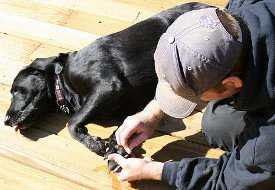|
Many of us dog owners have been there. One minute everything is fine; the next, you go on high alert when you realize, “Oh no, my dog is limping. Why?” There are many things that could cause a dog to limp with pain as the main symptom. Once you narrow down the site of the pain, you can help your dog feel better.
Here are 5 common reasons for why your dog is limping, plus what you can do to provide relief.
Limping Source #1: Paw Irritation
 Paw injuries or discomfort are common reasons for a dog to limp. Some common sources of paw pain: Paw injuries or discomfort are common reasons for a dog to limp. Some common sources of paw pain:
• Thorn, burr, glass, etc. is stuck in or between pads
• Pad is worn down and raw
• Snow has balled between pads, pushing them apart
• Nail has ripped to the quick (the nerve in the center of dog nails)
The Cure: Gently investigate your dog’s paw. If there is something stuck, try to remove it gently. Your dog may try to pull his paw away from you to protect a tender spot. Reassure him and get help from a partner or veterinarian if necessary. If the nail has been torn to the quick, gently dip the nail in corn starch, which will stop the bleeding.
You can also prevent paw injuries with the use of protective boots. Read More: How To Choose Protective Dog Boots
Limping Source #2: Wrist, Elbow, Or Knee Pain
Which is which? The wrist is the joint just above the front paws. The elbow is the joint above that. The knee is the joint partway up the back legs. These joints can get tweaked and injured just like in humans. The muscles and ligaments surrounding them can be injured as well.
The Cure: First of all, keep your dog in good shape. Don’t push him in strenuous activity that is beyond his physical abilities. If possible, limit his activity that is beyond his boundaries (many dogs let their excitement override their ability). This will minimize the potential for injury.
If your dog does get injured, stabilize the joint. Wrap an Ace bandage in a figure 8 pattern above and below the affected joint to prevent motion and further injury. Then, consult a veterinarian. Injury in this area ranges from simple soreness to torn ligaments or broken bones. It’s best to let a pro make that determination.
Limping Source #3: Shoulder Or Hip Pain
The shoulder is the joint above the elbow where the front leg connects to the torso; the hip is the joint above the knee where the back leg connects to the torso. Because of the connection to the torso, an injury here is a little more complicated to isolate. A limp based in this area could be a shoulder or hip injury, or it could be caused by injury or discomfort to a nearby region that translates to the leg.
The Cure: Anytime your dog is limping, it’s best to keep him as still as possible until you can get him to a veterinarian. Like the joint issues discussed above, it could be nothing or it could be something. It’s better to get a diagnosis quickly before it gets worse.
Limping Source #4: Broken Bones
Occasionally, a dog will break a bone. If your dog is limping, figure out which leg he won't put weight on and gently feel his toes, paw, and leg. If a toe or area between joints causes your dog pain, it may be a broken bone.
The Cure: This is an emergency with the potential to get worse. Call the veterinarian.
Limping Source #5: Progressive Or Chronic Conditions
There are many conditions beyond a one-time injury that causes dog limping. They fall into 3 main categories, which we’ll cover below and give examples for:
Limping may be caused by a genetic issue, like elbow dysplasia, a condition where the elbow joint is not properly formed. This is common in Chow Chows, Rottweilers, and many other breeds. A similar condition, hip dysplasia, is common in German Shepherds, Great Danes, and other dogs, mainly large breeds. X-rays identify these and other genetic causes.
Progressive, chronic conditions like arthritis may also be to blame. Arthritis usually appears later in a dog’s life and becomes progressively worse. With treatment, it can be slowed and/or made more tolerable for your dog. Treatment ranges from simple pain medication to physical therapy and more. Your veterinarian will be able to diagnose arthritis and other chronic conditions.
Other conditions that cause dog limping can come and go. My dog Nala once woke up with a limp not caused by any physical activity. X-rays showed a “joint mouse,” or abnormal cartilage growth, in her shoulder. It came on over time and, in her case, was likely to go away over time. In some cases, surgery is the best way to eliminate pain from a joint mouse. This is just one of many conditions that may appear in the course of a dog’s life and cause limping.
The Cure: Because so many issues fall into this category, there's no one cure. Have your veterinarian take a look and recommend the best course of action. If it’s a serious diagnosis, don’t be afraid to get a second opinion.
Why Is My Dog Limping?
Your dog may be limping for a number of reasons, ranging from temporary discomfort to injury to a chronic problem. Talk with your veterinarian so you can get your dog back to his normal self quickly.
Want help pinpointing the source of your dog’s limping? Use the Pet Symptom Checker, which will help you narrow down the source of your dog’s pain and give you information to ask your veterinarian. Click the image below to use the Symptom Checker:

If it is late at night or you don't have a regular vet, there are online resources available to you. Learn more about our favorites here.
If you liked this, you may also like:
Putting The Special In Special Needs - Our personal story of our dog with health issues.
Help, My Dog Keeps Throwing Up - 4 common causes and how to know when to call the vet.
Dog Hiking Boots - Extra durable protection from sharp rocks, thorns, and more.
Photo credit: Oakley Originals
|